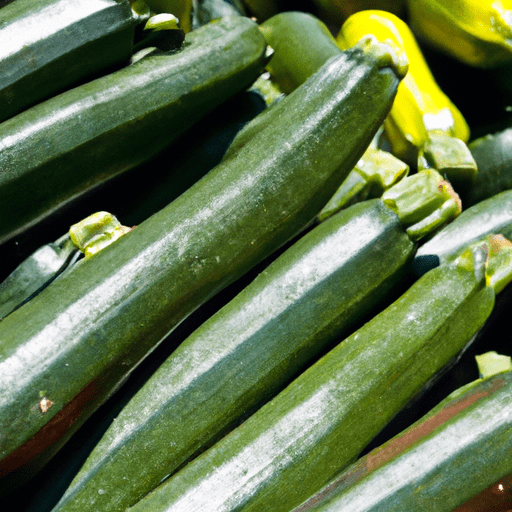The Versatile Courgette: A Summer Delight
If you’re looking to add some deliciousness and versatility to your summer cooking, look no further than the humble courgette. With its delicate flavor, crisp texture, and a wide range of culinary uses, courgettes are a popular staple in many kitchens around the world. Join us on a culinary journey as we explore the taste, common uses, nutritional value, and interesting facts surrounding this delightful summer vegetable.
Taste and Texture:
Courgettes, also known as zucchinis, have a mild and slightly sweet flavor with a tender and crisp texture. The taste is often compared to that of a cucumber but slightly sweeter and less watery. The tender flesh of a courgette boasts a subtle nuttiness, making it a versatile ingredient in a variety of dishes.
Culinary Uses:
Courgettes can be enjoyed in a multitude of ways, making them an excellent addition to your culinary repertoire. Here are a few popular ways to use courgettes in your cooking:
Raw: Thinly sliced or grated, raw courgettes can be added to salads, slaws, or used as a refreshing garnish. Their crisp texture adds a delightful crunch and their subtle flavor complements other ingredients.
Grilled or Roasted: When cooked on a grill or roasted in the oven, courgettes develop a lovely char and a smoky flavor. Simply brush them with olive oil, season with salt and pepper, and cook until tender. They make a perfect side dish or a delicious addition to pasta dishes, pizzas, or sandwiches.
Sautéed or Stir-Fried: Courgettes can be swiftly sautéed or stir-fried to create a quick and flavorful side dish. Add them to stir-fries, pasta sauces, or noodle dishes for some added freshness and texture.
Stuffed: Hollowed-out courgettes can be filled with a variety of fillings, such as cheese, rice, meat, or vegetables. Baked until tender, stuffed courgettes make for an impressive and satisfying main course.
Baked: You can also bake courgettes into casseroles, gratins, or frittatas. They add moisture and a delicate flavor to these comforting dishes.
Courgettes truly shine in their ability to enhance a multitude of dishes, offering a delicate and fresh flavor to both cooked and raw preparations.
Nutritional Value:
Not only are courgettes delicious, they are also highly nutritious. Low in calories and carbohydrates, courgettes are a great choice for those seeking to maintain a balanced and healthy diet. Here are a few key nutritional highlights:
Vitamin C: Courgettes are an excellent source of vitamin C, which plays a vital role in supporting immunity and overall well-being.
Fiber: Rich in dietary fiber, courgettes contribute to a healthy digestive system and can promote feelings of fullness, aiding in weight management.
Water Content: With a high water content, courgettes are hydrating and help maintain hydration levels.
Antioxidants: Packed with antioxidants like carotenoids and lutein, courgettes can help protect cells from harmful free radicals.
Including courgettes in your meals can be a flavorful way to boost your nutrient intake and support a healthy lifestyle.
Fun Facts about Courgettes:
As we explore the world of courgettes, let’s uncover some interesting facts about this summer delight:
Courgettes are a member of the cucurbit family, which includes other popular vegetables like cucumbers, melons, and pumpkins.
The name “courgette” is derived from the French word “courge,” meaning vegetable marrow.
While courgettes are typically harvested and enjoyed when immature and small, if left to ripen, they can grow into larger sizes and develop a harder skin. At this stage, they are known as marrows.
Courgettes come in different colors, including green, yellow, and white. The green variety is the most common in most parts of the world.
The largest courgette on record weighed a whopping 65 pounds (29.5 kilograms)!
Conclusion:
Courgettes, with their delicate flavor and versatility, offer endless possibilities in the kitchen. Whether you’re preparing a light salad, a hearty casserole, or a quick stir-fry, courgettes can add a touch of freshness and nutrition to your creations. So, make the most of this summer delight and explore the countless culinary adventures that courgettes have to offer.
Courgette
Origin: Courgette, also known as zucchini, belongs to the Cucurbitaceae family, which includes cucumbers, melons, and squash. It is believed to have originated in the Americas, specifically in Mesoamerica.
Common Uses: Courgette is a versatile ingredient commonly used in Mediterranean, Middle Eastern, and American cuisines. It is often consumed in its immature stage when the skin is still tender and the seeds are small. Courgettes can be eaten raw, sliced and added to salads, or cooked in various ways such as grilling, steaming, roasting, sautéing, or frying. They are also popular for using in zucchini bread, soups, stews, and stir-fries.
Nutritional Benefits: Courgettes are low in calories and a good source of vitamins and minerals. They contain significant amounts of vitamin C, providing about 35% of the recommended daily intake per 100 grams. They also contain vitamins A, K, and B6, as well as folate and potassium. Courgettes are also a good source of dietary fiber, which aids in digestion and can promote feelings of fullness.
Unique Properties: One unique property of courgette is its high water content, which makes it particularly refreshing and helps keep the body hydrated. Additionally, courgettes are rich in antioxidants, including carotenoids like lutein and zeaxanthin, which promote eye health and may help protect against age-related macular degeneration.
Historical Significance: Although courgette is most commonly associated with Mediterranean cuisine, its introduction to Europe is relatively recent. It was brought back from the Americas by Christopher Columbus during his voyages in the late 15th century, but it took several centuries for it to be widely cultivated and embraced in European cooking. Courgette was first mentioned in an Italian agricultural book in the late 1800s and quickly spread in popularity throughout Europe and the rest of the world.




Use the share button below if you liked it.
It makes me smile, when I see it.